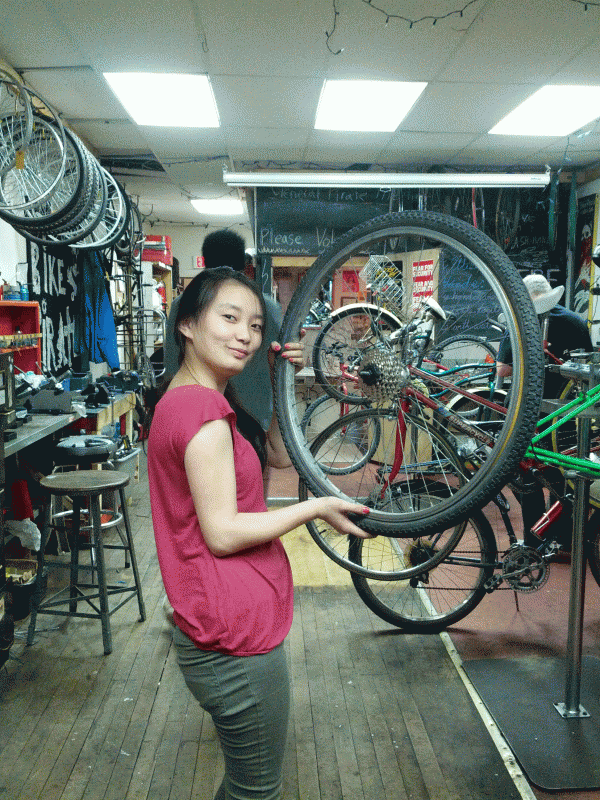
This post by Jeffrey Trieu is part of Spacing‘s partnership with the Toronto Cycling Think and Do Tank at the University of Toronto. Find out more about the think tank, and the series, here.
With countless community events being hosted from May 25th to June 25th, the Greater Toronto and Hamilton Area is anticipating Bike Month 2015. Municipalities and community groups alike are hosting the A to Z in bike events, from food incentivized group rides to bike repair crash courses. Although cycling mode shares are still relatively low in Toronto, they are trending upwards; hence, the cause for celebration! In fact, in a two decade long review of trends in cycling rates, infrastructure, and policies, John Pucher and his colleagues suggest that many large North American cities, including Toronto, are undergoing a bicycle renaissance. According to Transportation Tomorrow Survey data[1], all adult age demographics (including seniors!) have seen an increase in cycling rates in the past decade and half. In 2001, 1.18% of all trips were taken by a bicycle for folks 18 years of age and older. Ten years later in 2011, this rate has risen to 1.96%.
However, cycling in Toronto has not been booming for all its residents, particularly those who would benefit most from a transportation mode unrestricted by age-enforced licensing. Cycling rates for Toronto youth have remained stagnant over the recent past and in some cases, have seen decline. In 2001, 1.02% of all trips were taken by a bicycle for Torontonians aged 11 to 17. This rate inched to 1.04% in 2011. Moreover, in Ron Buliung and colleagues’ examination of school travel patterns among Toronto youth, bicycle trips comprised 1.7% of school trips in 1986, then dropped to 0.8% in 2006.
This Toronto youth cycling trend is quite contradictory to the contemporary public health emphasis on youth physical (in)activity. Sixty minutes of physical activity is the daily recommended dose for young folks, yet only 4% of Canadian adolescents are achieving this benchmark. The bicycle combines physical activity with utility; biking simply to get to everyday destinations is a feasible means to sneak in exercise. Moreover, the backseat generation lacks opportunities to be independently mobile – free to travel in their urban space as they wish. Here, the bicycle may be framed not only as a tool for physical health, but for exploration and autonomy as well.
It is quite exciting then, that this year’s Bike Month will be accompanied by the region’s inaugural Bike to School Week from May 25th to the 29th. Over 100 schools (and counting!) across the Greater Toronto and Hamilton Area have registered to participate in this week-long event. Registration essentially means that participating schools will be delivering cycling-related events leading up to or during the Week, with the potential opportunity to snag prizes.
Perhaps, it is too early to dub Bike to School Week a celebration of youth cycling in the region as Toronto youth cycling rates have not been climbing upwards as they have been with adults. Numerous factors are at play here: parental fears, lack of infrastructure, inaccessibility, or perhaps concern over helmet head. Still, Bike to School Week has the potential to be something more interesting than a celebration of biking in my eyes. It can be a catalyst for change. The idea of Toronto undergoing a bicycle renaissance is quite uplifting; however, it does not occur over one week or one month. It requires long term investment and engagement from numerous stakeholders, ranging from the chief city planner to the average city cyclist. So as our bicycle renaissance rolls on, let’s not leave behind our youngest companions. Bike Month and Bike to School Week is a time for folks across the Greater Toronto and Hamilton Area, young and old, experienced and uncertain, to hop on a bicycle. Of course, it is healthy and environmentally sustainable. But, let`s not forget, it is also fun.
[1] The Transportation Tomorrow Survey (DMG, 2014) measures travel modes across the city. If these rates still seem unimpressively low, bike mode shares are substantially higher in particular downtown neighbourhoods. However, suburban-urban cycling is a whole other discussion in itself.
The post Rolling Youth into Toronto’s Bicycle Renaissance appeared first on Spacing National.





















